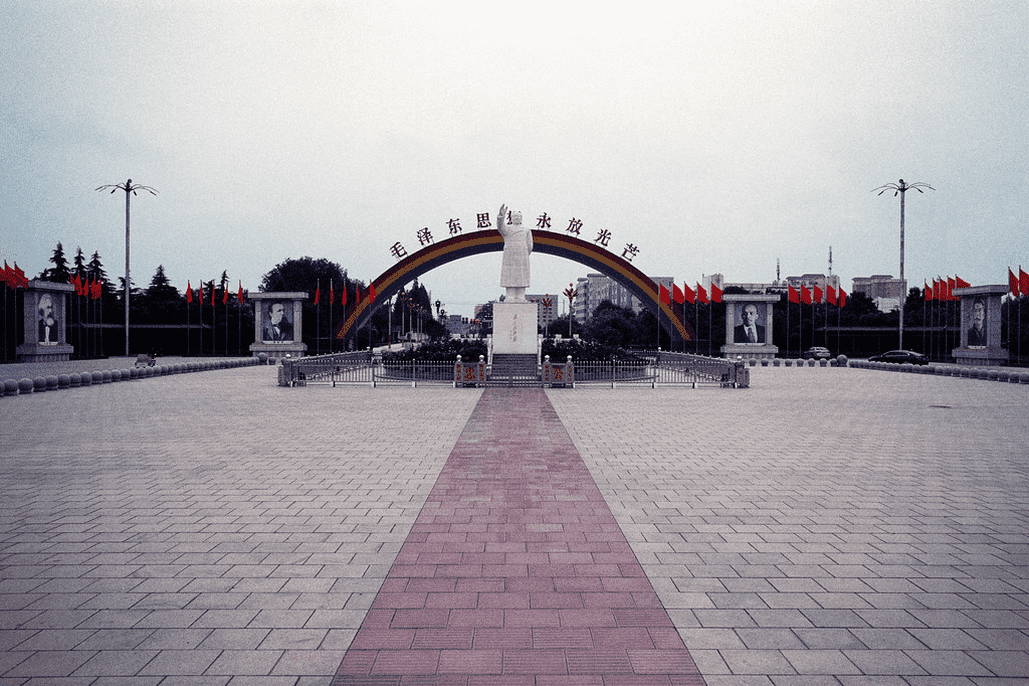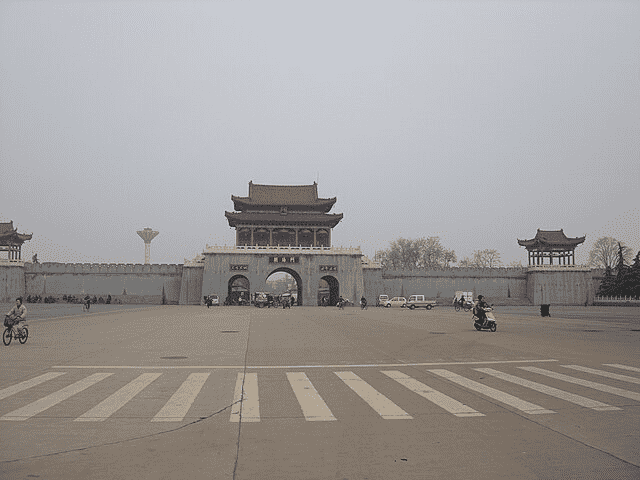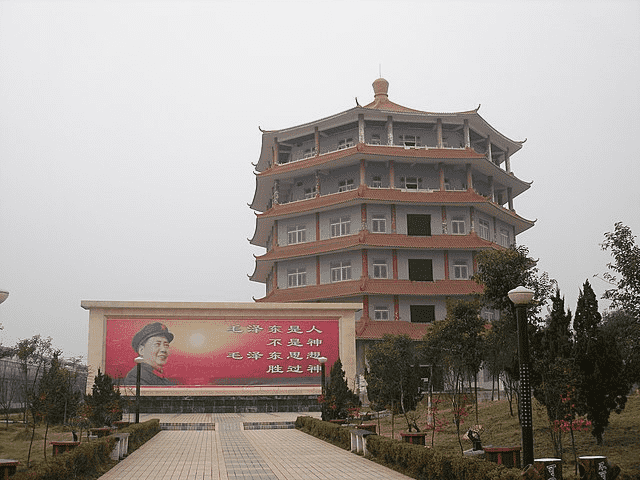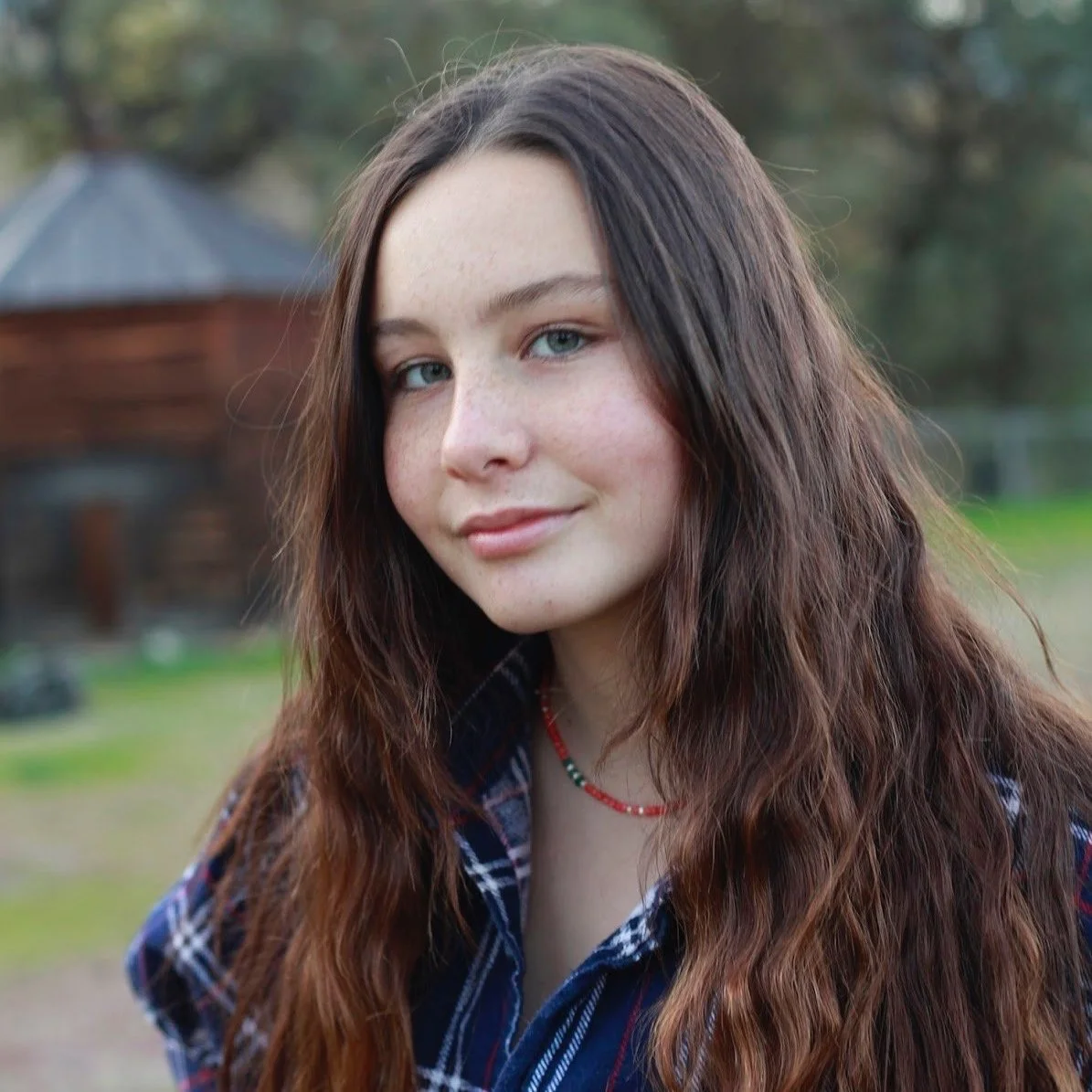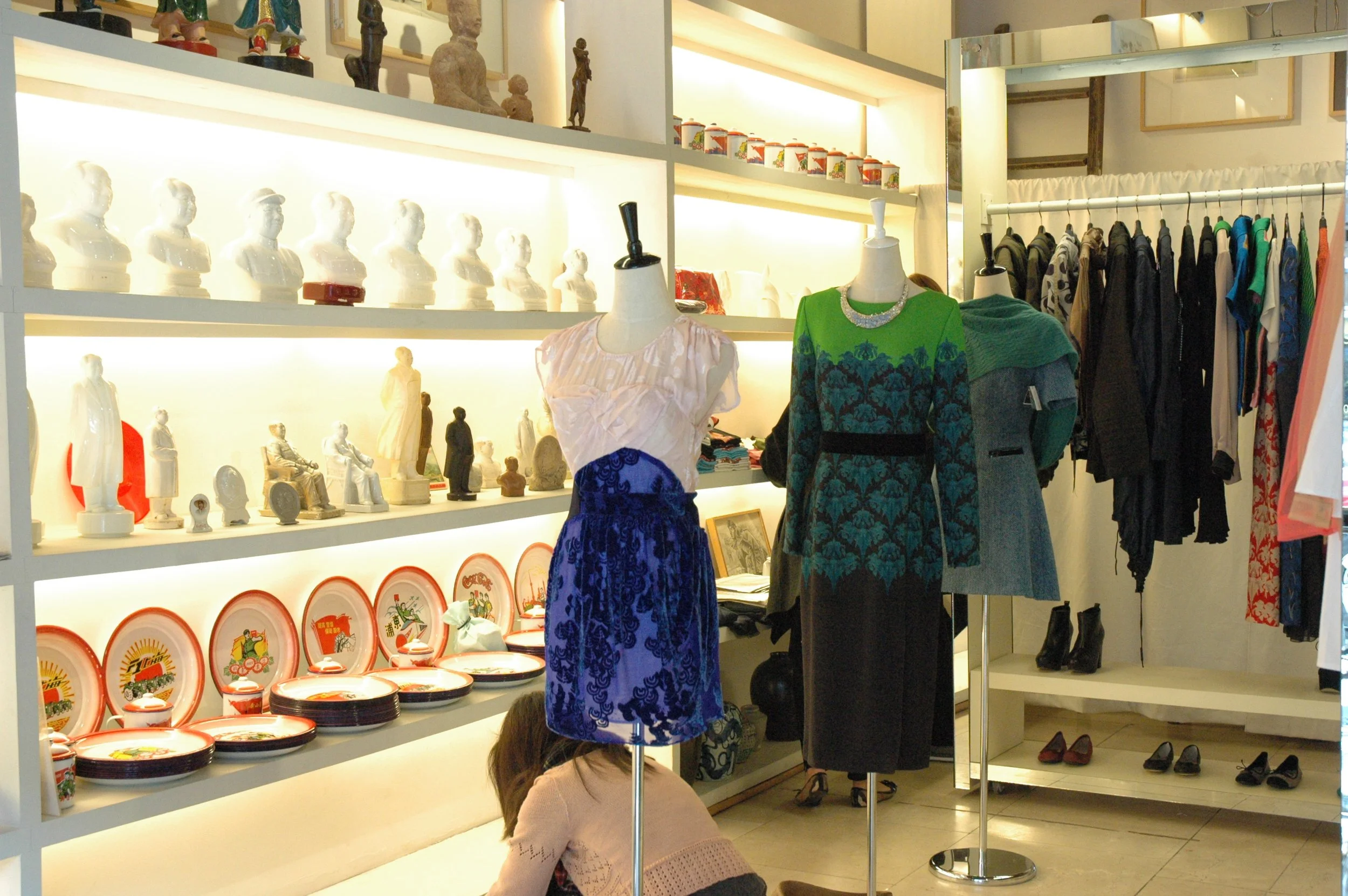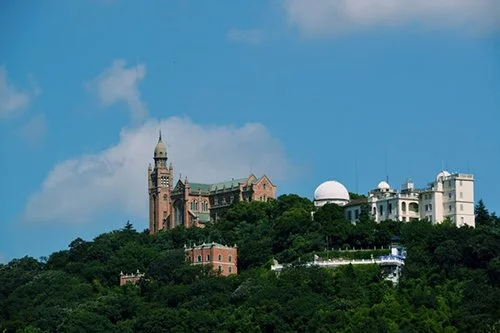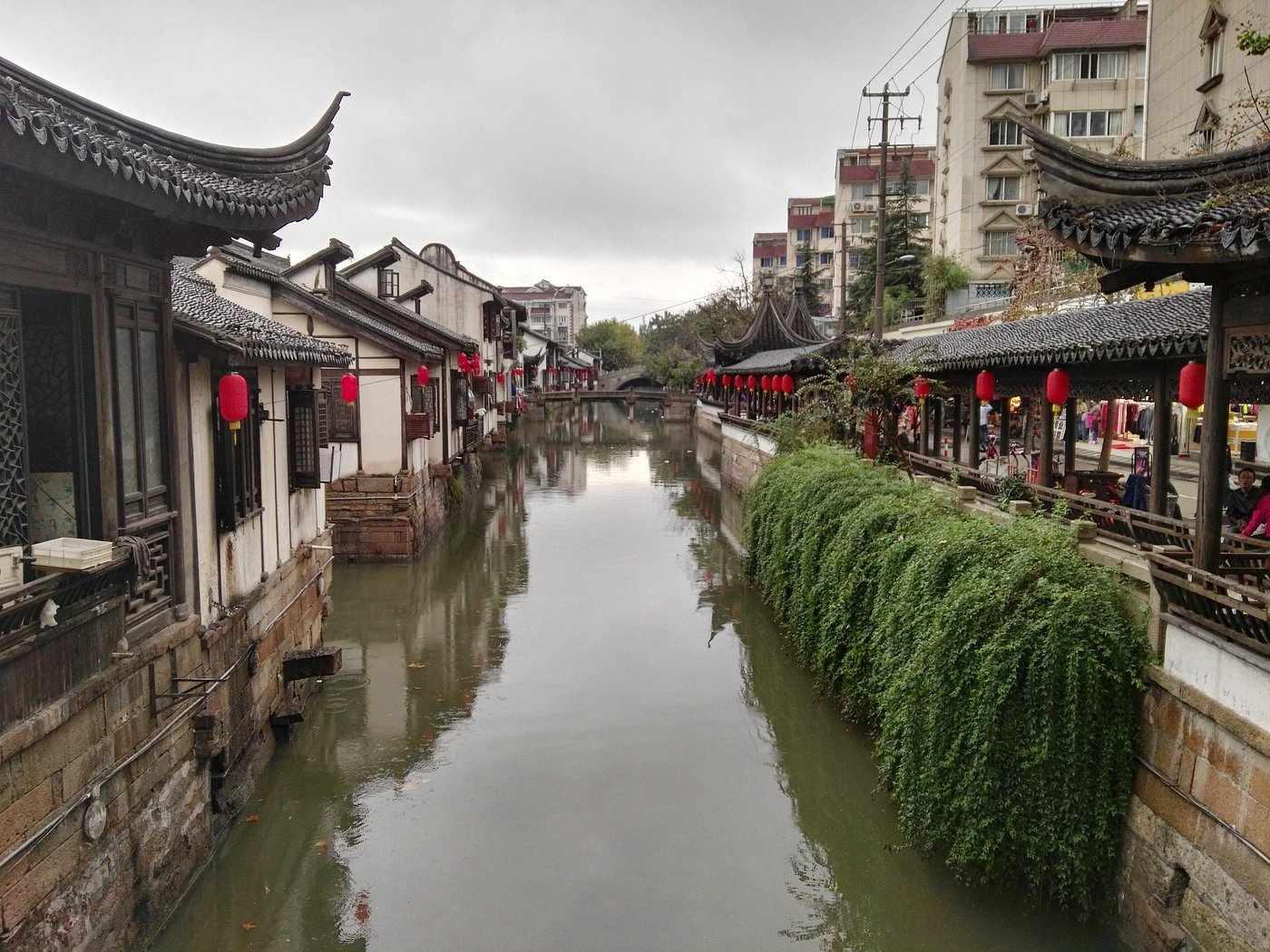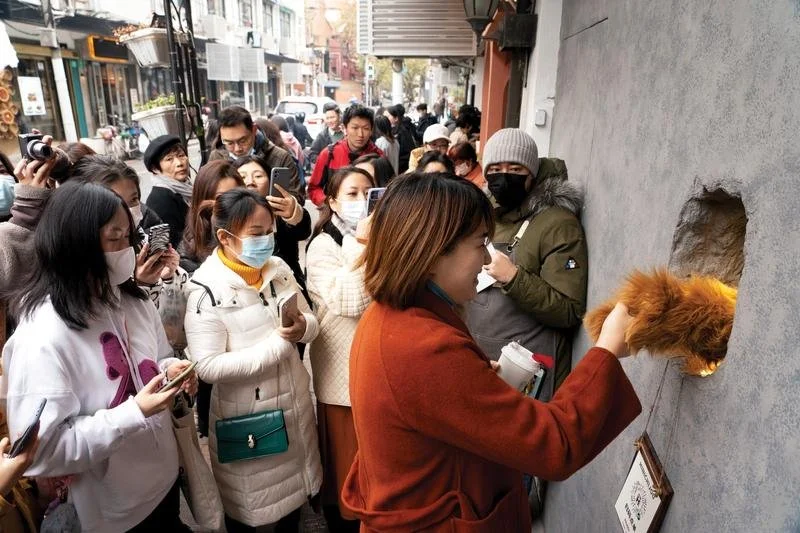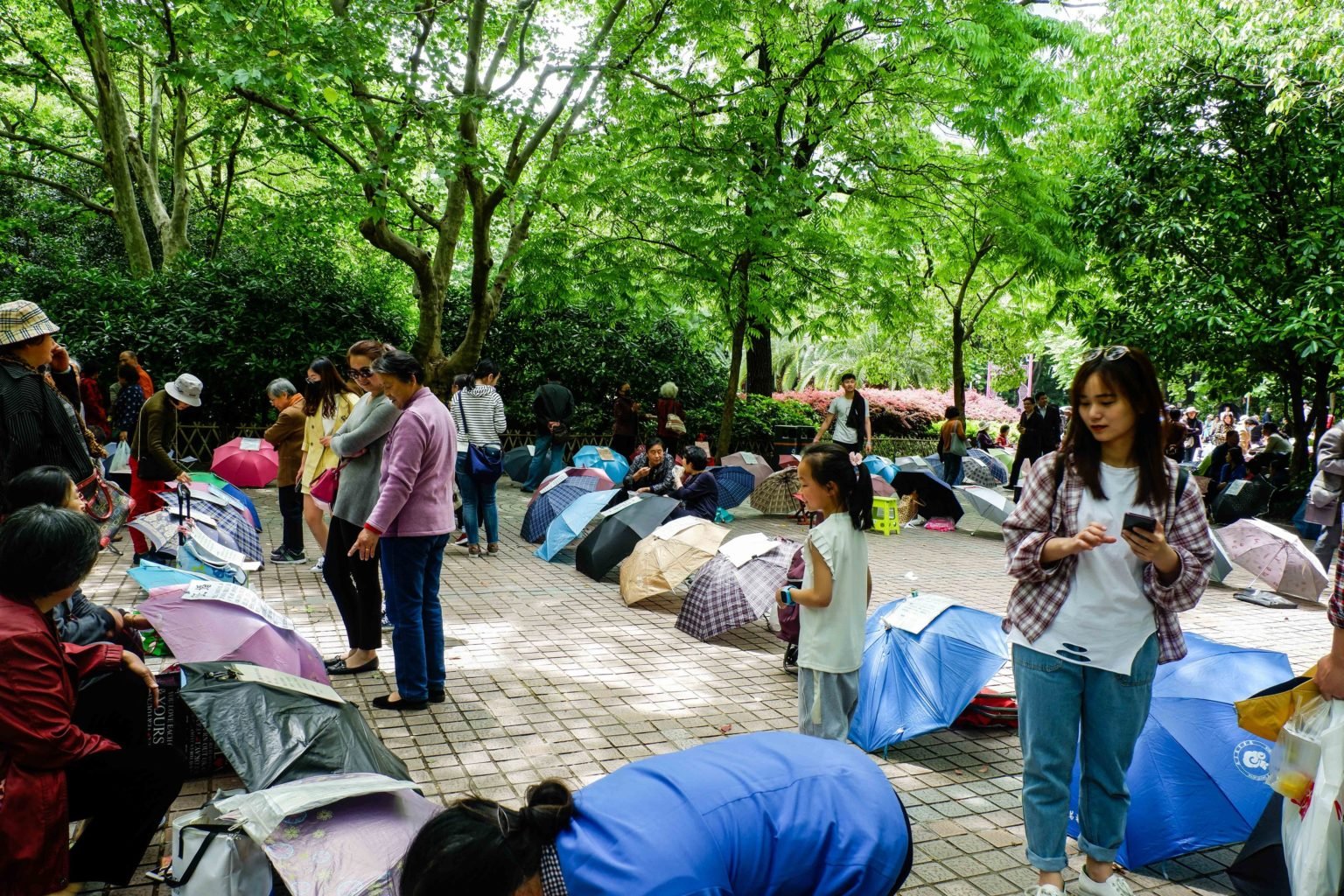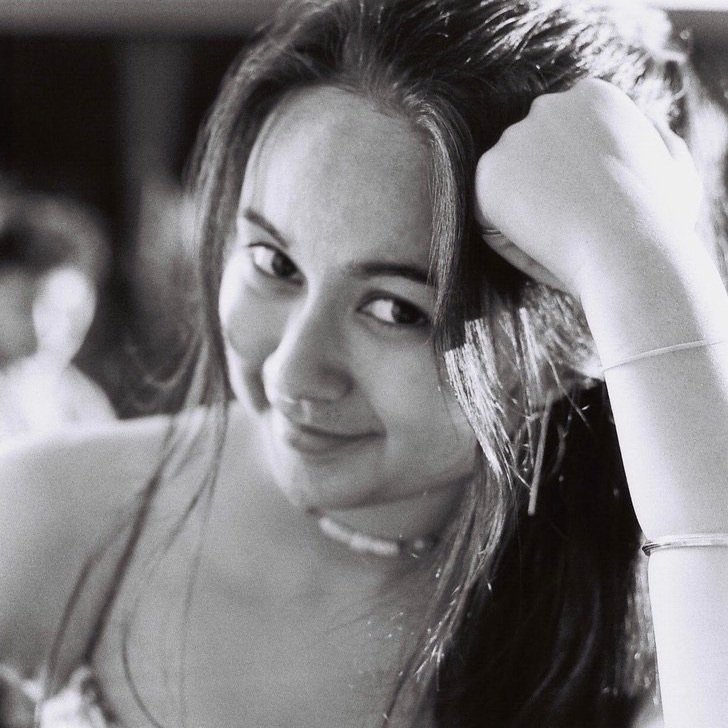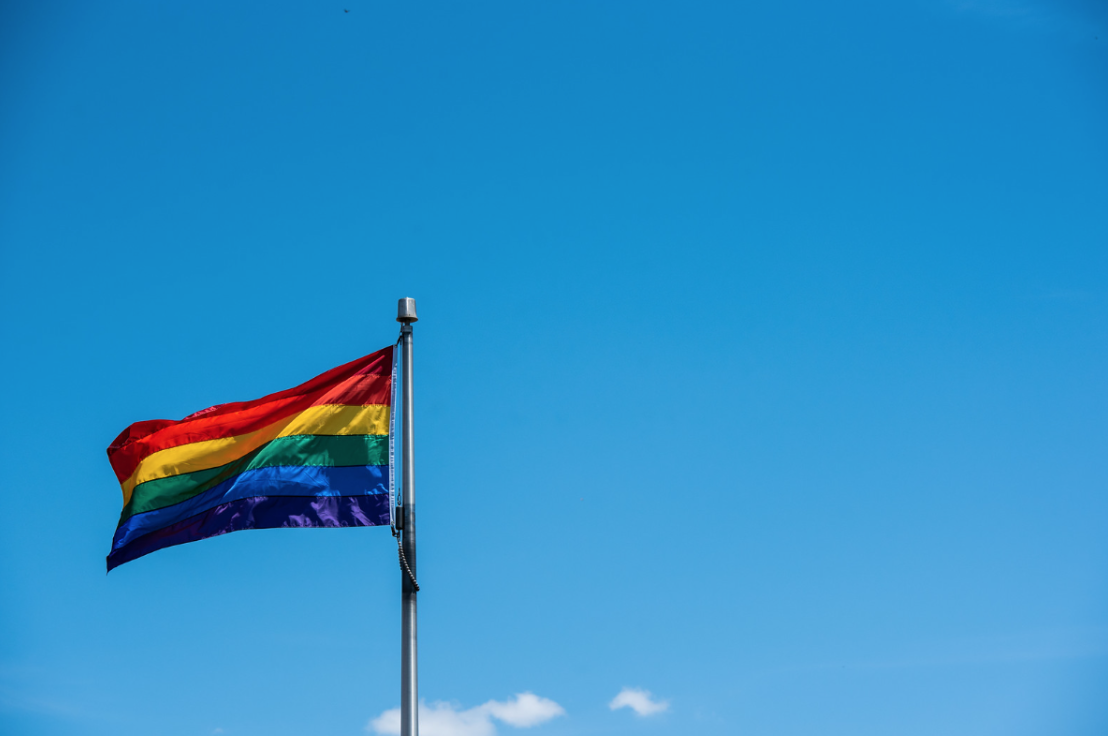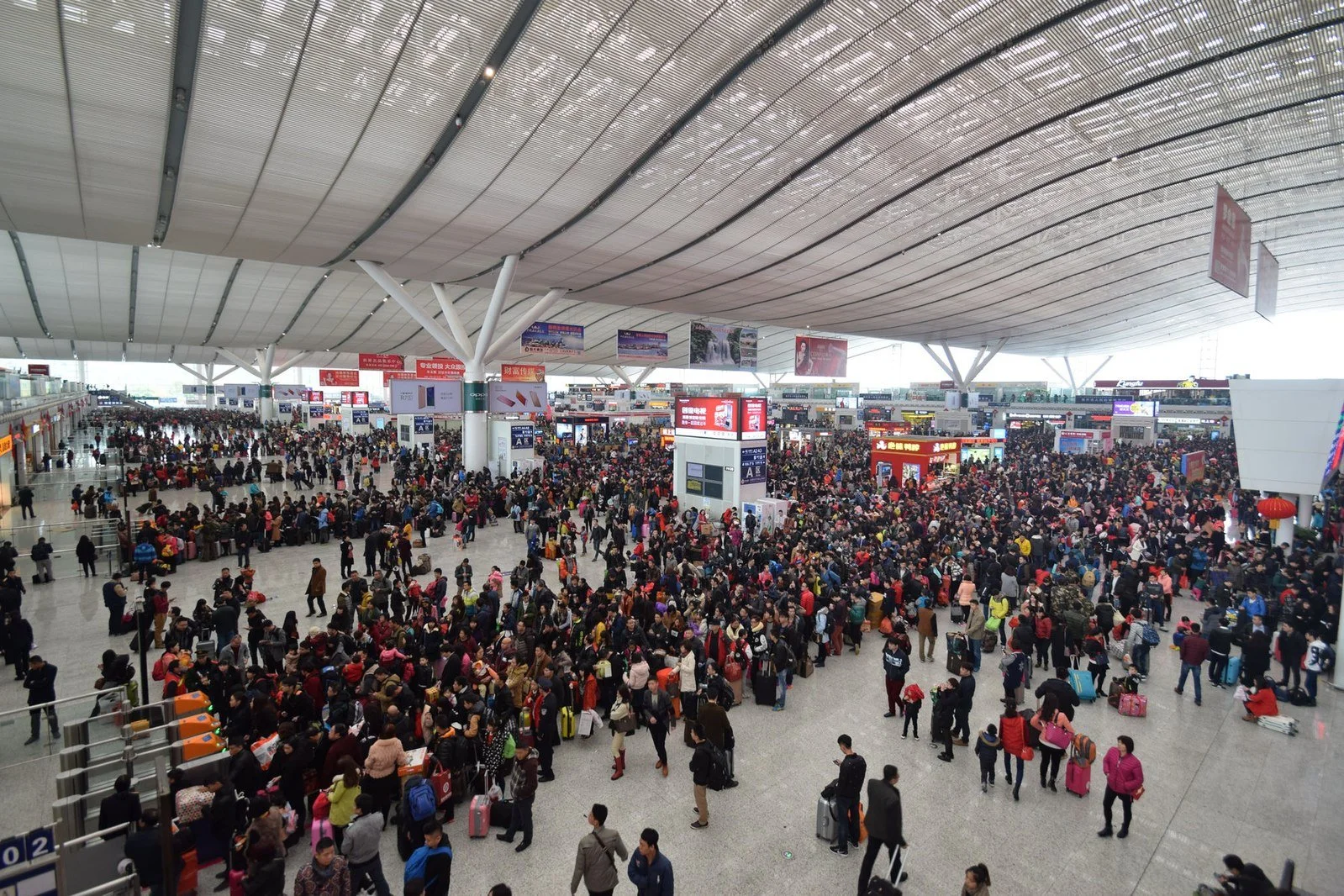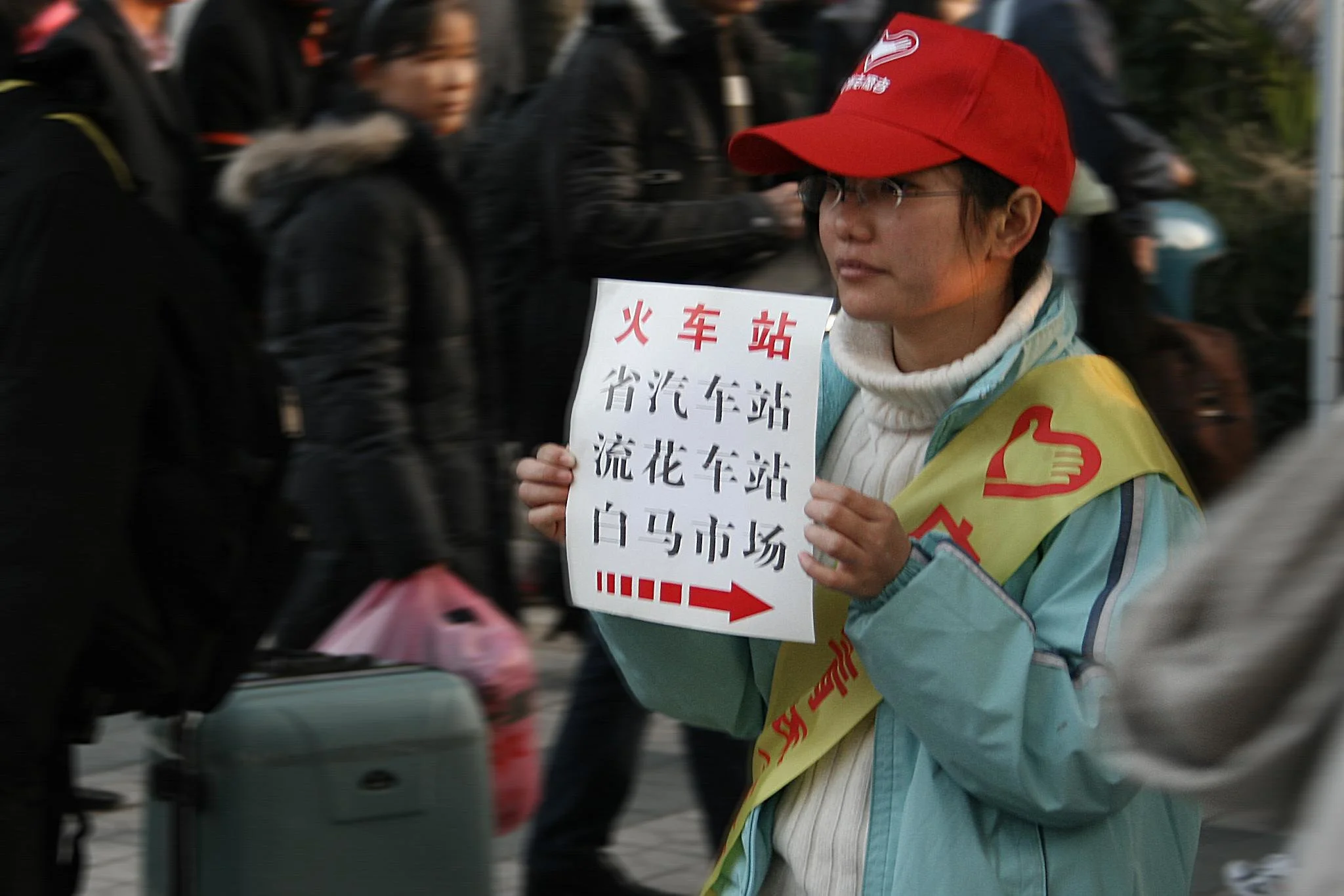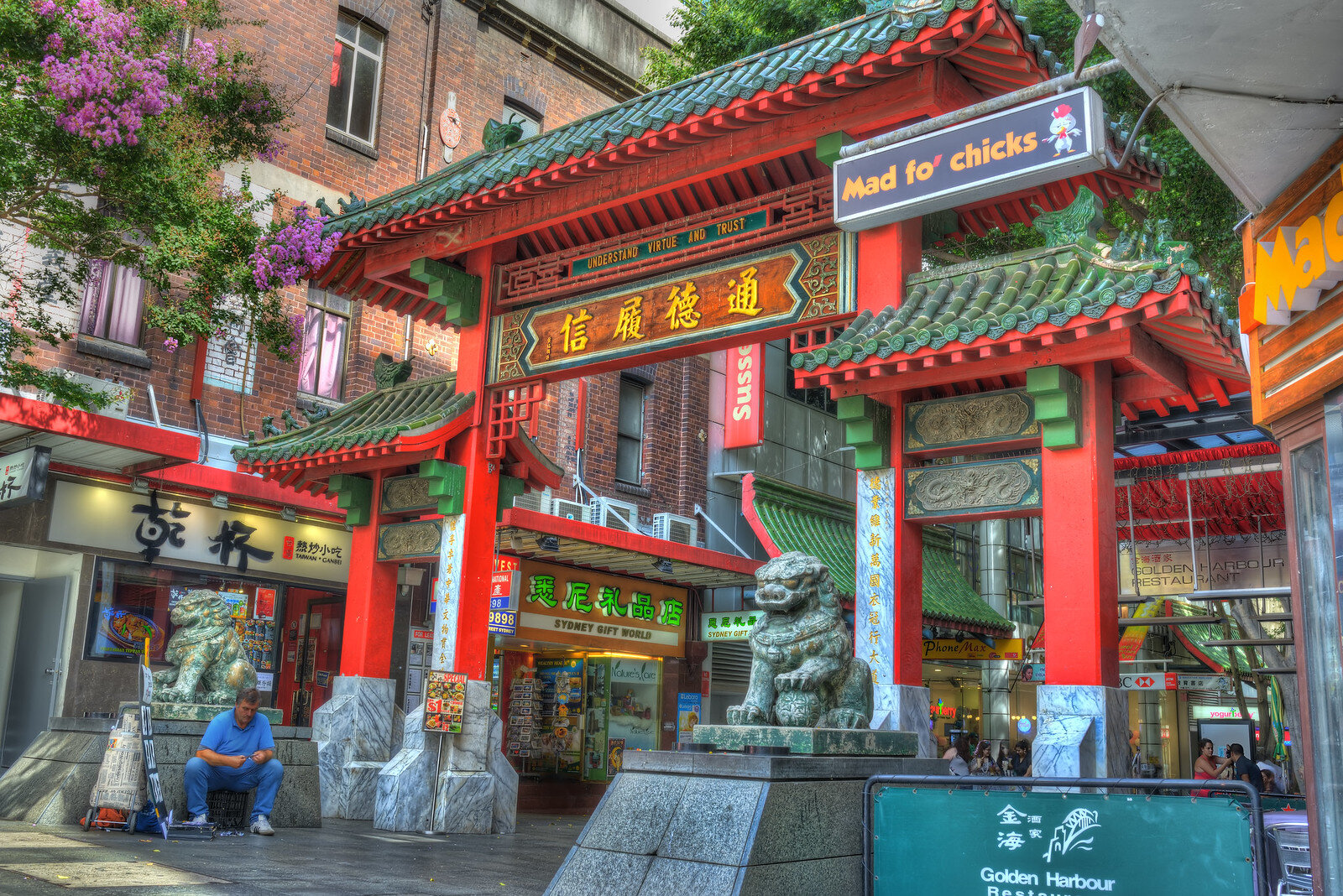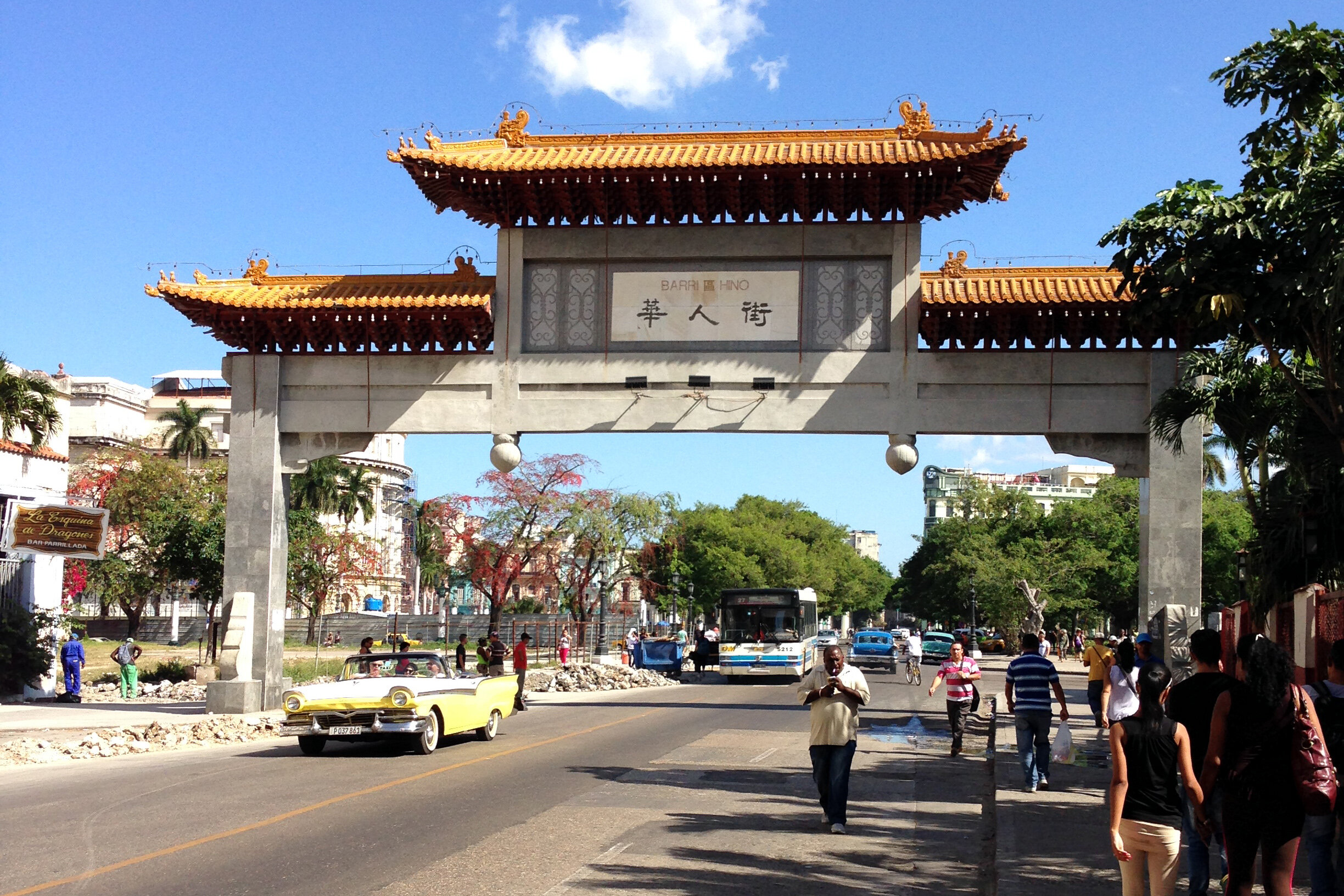Uyghur people in China are subjected to forced labor in the seafood industry, enduring brutal conditions and human rights abuses on fishing vessels and in processing plants.
Read MoreCelebrating Lunar New Year Across China
Falling on Jan. 29, 2025, the Lunar New Year is a time of celebration across China, commemorated by unique traditions found in each of its culturally diverse regions.
Read MoreNanjie: A Living Memory of Maoist China
In the small Chinese village of Nanjie, residents live in a time capsule of the Cultural Revolution.
The East is Red Square. Nicolas Oddo. CC BY-ND 2.0
While China’s Cultural Revolution officially ended in 1976 with the death of Chairman Mao Zedong, the more than 3,000 residents of Nanjie, in Central China’s Henan province, continue to live by the principles of Maoism. While the village is reportedly one of China’s wealthiest, having grown its economy by nearly 2,000 fold in just ten years, workers in the village’s factory have agreed to accept a monthly salary of only about $400. In the 1980s, when the rest of China was opening up to the capitalist market, Nanjie chose to revert to the system of collective ownership taught by Mao.
Nanjie Commune Gate. Gary Lee Todd. CC0 1.0
Nanjie is small, comprising about two dozen factories and several main streets. Mao Zedong’s face is displayed all over the village in the form of billboards, posters and framed portraits. A giant statue of the Cultural Revolution’s late leader can be found in the middle of the town’s main square, the “East is Red” Square. On each side of the looming statue are portraits of four other famous communists: Karl Marx, Friedrich Engels, Vladimir Lenin and Joseph Stalin. North of the square stands the traditional-style Chaoyang Gate, decorated with a portrait of Sun Yat-sen.
In the square, a speech from Mao is played on a perpetual loop. New party members take their oaths in the square. On National Day, all couples in the village get married in a single collective ceremony and bow to the statue of Chairman Mao. As a wedding gift, they receive copies of Mao’s “Little Red Book.”
Nanjie Commune. Gary Lee Todd. CC0 1.0
The village's economy is dominated by collective ownership and management of all production and rationing supplies like coal, cooking oil, candy and even cigarettes. Residents are awoken each morning by “Dongfang Hong” (“The East is Red”), the de facto anthem of the Cultural Revolution, playing over loudspeakers. While some residents have chosen to leave the village in pursuit of capitalist success, many prefer the commune lifestyle free from the stress of higher living costs and housing loans.
Exterior of Nanjie Commune Apartments. Gary Lee Todd. CC0
Interior of Nanjie Commune Apartment. Gary Lee Todd. CC0 1.0
Since the 90s, almost all village inhabitants have been living in collectively built apartments, with rent often funded by welfare. Every month, each resident receives vouchers of about $13 to cover the cost of food and groceries at the village’s commune-style supermarket. Locals also receive free healthcare and education.
Nanjie Commune Greenhouse. Gary Lee Todd. CC0
Nanjie even has a theme park dedicated to the history of the Chinese Communist Party, featuring re-creations of significant historical events and a $1.2 million greenhouse. The garden houses more than 500 flower species and 10,000 plants, as well as sculptures of animals like kangaroos and dinosaurs. Aside from the theme park and the greenhouse, the village also houses five parks, a zoo, a small artificial mountain set with bridges over a moat, a large swimming center and a grand mosque. While the village itself might be small, its historic, almost museum-like preservation, unique cultural heritage and the pride that locals take in their way of life make for a fascinating window into a bygone era.
GETTING THERE
Traveling to the collective is not difficult. From Zhengzhou, the capital of Henan province, buses (Y31; two hours) run south to Linying every hour between 6:40 am and 6:10 pm local time. From Linying it is a 1.2-mile walk south to Nanjie on the east side of the road. Taxi cabs are also available. Hotels are available in Nanjie and the surrounding areas.
Rebecca Pitcairn
Rebecca studies Italian Language and Literature, Classical Civilizations, and English Writing at the University of Pittsburgh. She hopes to one day attain a PhD in Classical Archeology. She is passionate about feminism and climate justice. She enjoys reading, playing the lyre, and longboarding in her free time.
Big Brother is Watching: China’s Social Credit System
The nuanced nature of China’s social credit system has sparked global debate.
People walking through crowded streets in Shanghai. Rawpixel. CC0 1.0
Amid social and political turmoil, many are fascinated by order, hierarchy and control. One of China’s long-term goals is technological self-reliance, reflected in the country’s controversial social credit system. Millions of citizens are defined by and reduced to a numeric value, which is generated as their daily interactions and purchases are closely monitored. The system was predominantly economic—similar to a FICO score—until 2004, when President Jian Zemin expanded the system by adding a social aspect. The current social credit system was formally introduced in 2014, and by 2022, 80% of China’s cities, counties and regions had instituted some version of it.
The social credit system varies geographically. Some citizens receive a numeric score between zero and 1,000, while others are marked by a letter score from A to Z. The system is divided into four categories: business, social, government, and judicial. It operates punitively, rewarding citizens for good behavior and punishing them for bad behavior. A drop in one's score can come from traffic violations, littering and gossiping, while good deeds like donating to charity and assisting the elderly can increase it. The more points accrued, the more preferential treatment one receives, including discounts and travel perks. However, if a citizen's score is too low, they can be prevented from traveling or landing work. In 2019, millions of Chinese citizens were banned from buying plane tickets due to low social credit scores. China’s social credit system has been compared to the Black Mirror episode "Nosedive," which depicts dystopian society in which one’s worth is defined in relation to their portrayal on social media.
Surveillance equipment. Rawpixel. CC0 1.0
The government claims that the social credit system was instituted to “build trust” amongst citizens. However, the lack of privacy and blacklist perpetuated by the system has sparked global concern. Even by criticizing the government, your social credit score is lowered, and in some cities, the government pays citizens to report good or bad behavior. Recent studies suggest that the portrayal of China’s social credit system in the media is exaggerated. According to the MIT Technology Review, the system primarily functions as a comprehensive record of data, documenting companies’ financial histories. It is therefore less important as a single score than as a record.
The social credit system is only one aspect of government surveillance in China. The country’s firewall limits internet searches, and there are at least 200 million surveillance cameras installed that can use facial recognition software. China’s government operates without rule of law, leading to the abuse of power. Surveillance capitalism ultimately poses a threat to individual autonomy and democratic governance. The question remains as to how far it will spread in the coming years.
Agnes Volland
Agnes is a student at UC Berkeley majoring in Interdisciplinary Studies and minoring in Creative Writing, with a research focus on road trip culture in America. She currently writes for BARE Magazine and Caravan Travel & Style Magazine. She is working on a novel that follows two sisters as they road trip down Highway 40, from California to Oklahoma. In the future, she hopes to pursue a career in journalism, publishing, or research.
China’s Rainbow Mountains
Eons of time and colossal tectonic plates have shaped China's most colorful national treasure.
Read MoreThe Extensive Cuisine of Chinese Muslims
From pita bread to lamb, halal Chinese food’s influences stretch from the Mediterranean to Russia and from China to the Middle East.
Street vendors feed crowds with a doughy treat in Urumqi, the capital of China’s Xinjiang Uyghur Autonomous Region. People’s Development Bank. CC BY-NC-ND 2.0.
China has around 23 million Muslims, predominantly made up of the Hui and the Uyghur ethnic groups. Chinese Islam began in 651 A.D., when Islam was first introduced to the country by Arab traders under the Tang dynasty. A diverse array of religions and cultures were brought to Tang China, including Islam, Judaism and Zoroastrianism. However, Islam was the only religion of these to make a lasting impression on the Chinese population. Chinese Islam expanded to different regions and soon developed its own local traditions and foods. The culinary wealth that sprang from Chinese Islamic heritage progressed into popular street foods and dishes still consumed by Chinese people today.
Hui Cuisine
Hui Muslims mostly occupy areas in the Ningxia autonomous region in China’s northwest. Their cuisine is called “qingzhen cai,” loosely meaning “pure truth” in Mandarin. This reflects the widely associated cleanliness of qingzhen restaurants due to their prohibition on smoking and drinking alcohol. Hui cuisine quickly spread across China due to its unique and much-loved flavors.
Close-up shot of aiwowo. Dozen Dessert. CC BY 2.0.
A decadent Hui dessert that remains popular among street vendors is aiwowo, or “love drops.” These small round buns are made of sweet glutinous rice flour and are dusted with a blend of sesame seeds, sugar and walnut kernel chips. Though aiwowo’s inspiration is from Hui cuisine, the snack has become a popular roadside treat in Beijing.
Lanzhou beef noodles in a hot and earthy broth. Language Teaching. CC BY 2.0.
Another seminal dish of the qingzhen cai tradition is Lanzhou beef noodle soup. Many consider this soup to be the most famous noodle dish in all of China. The base of this hearty dish is an aromatic beef broth boiled with cumin seeds, Sichuan peppercorns, onions, ginger, star anise and cinnamon. The fresh, chewy hand-pulled noodles are placed in the broth on a bed of beef slices and chili oil.
Uyghur Food
Uyghurs first came to China around the 3rd century A.D., and ruled over their own kingdom in the 8th century in present-day northern Mongolia. Today, Uyghur populations are concentrated in the Xinjiang Autonomous Region in far northwest China. The Chinese government has recently gained notoriety for setting up large-scale prison camps in Xinjiang, with critics calling it a “genocide” and an attempt to entirely wipe out the Uyghur populace.
Uyghurs tend to draw flavors from Central Asian, Middle Eastern and Chinese cuisines. Both the Hui and the Uyghurs base their dining experience around beef and lamb, avoiding pork due to religious purposes.
However, Uyghur foods draw far more on their Turkish influence: baked goods such as girda naan, similar to bagels, are central to their cuisine.
A vendor prepares lamb kebabs on a coal-fired barbecue for a busy night in Xinjiang. S. Tsui. CC BY-NC-ND 2.0.
In Xinjiang’s capital of Urumqi, visitors can find local vendors selling mutton kebabs, which are pieces of sheep flavored with cumin, paprika, salt and pepper, placed on a skewer and seared over smoky charcoal.
Roasted lamb from a halal restaurant in Beijing. Ulterior Epicure. CC BY-NC-ND 2.0.
Perhaps the most famous Uyghur-inspired dish is roasted whole lamb. Rubbed with a spicy menagerie of cumin, salt, ginger and pepper, the lamb is coated with a flour and yolk batter and baked in a special oven for an hour. This dish is considered a luxury that deserves only the highest-quality meat.
Pile of nang in Xinjiang. Umami. CC BY 2.0.
Another famous Uyghur staple is nang, which is reminiscent of naan bread: a flat pancake-like bread made of corn flour, wheat flour or sorghum flour. This is a building block of Uyghur cuisine, as it comes in a multitude of flavors and seasonings, from a savory sesame coating to a buttery sweet glaze.
Chinese halal food is embraced all over China today, as it continues to combine influences from around the world into culinary treats. With the expansion of Hui and Uyghur influences into Chinese food culture, the intermingling of various flavors will only broaden the appeal of this special cuisine.
Heather Lim
recently earned her B.A. in Literatures in English from University of California, San Diego. She was editor of the Arts and Culture section of The Triton, a student-run newspaper. She plans on working in art criticism, which combines her love of visual art with her passion for journalism.
Off The Beaten Path in Shanghai
From cultural collections to ancient architecture, here are 6 of Shanghai’s esoteric sites.
Shanghai’s skyline hides a city that blends historic culture and ancient tradition. Azizofegypt. CC BY-SA 2.0
The bustling metropolis of Shanghai is home to a whopping 26.3 million people, with an additional 632,000 tourists journeying to experience the city’s incredible history and traditions each year. Beyond the Bund’s iconic skyline and unbeatable nightlife, however, lie a treasure trove of hidden museums, culinary experiences and historical landmarks all waiting to be discovered. These lesser known enclaves will take you off the traditional tourist trails along the Bund or up the Pearl Tower, and will introduce you to new sides of the city’s multifaceted personality and culture.
1. Madame Mao’s Dowry
Madame Mao’s Dowry is chock full with vintage and modern Mao-inspired designs. Shanghai Collected. CC BY-SA 2.0
Whether you're an avid fashionista, a history enthusiast or simply curious about China's cultural heritage, a visit to Madame Mao's Dowry promises a full introduction to the impact of the Cultural Revolution and Mao Zedong’s rule on contemporary Chinese design. Its collection of artifacts ranges from photographs and posters to clothing and stationery, all displayed on antique furniture dating between 1949 and 1976, a period known eponymously as the Mao Era. Since 2001, Madame Mao’s has endeavored to highlight the complex connection between Mao’s political legacy and art by running various projects that encourage the use of old propaganda in modern visual art culture. In addition to the vintage items, the store also displays pieces by a handful of local Shanghai artists whose work draws from and reflects the artistic trends of the era, as well as housing their very own line of Mao-inspired paraphernalia. The intimate cultural space is occasionally transformed into a salon in partnership with Literary Shanghai, and hosts poetry readings, writing workshops and book launches among other events. Located in the Jing’An neighborhood to the west of the river, this store cum museum is definitely worth a visit.
2. Sheshan National Forest Park
Sheshan Basilica and the observatory sit atop the highest peak in the forest park. Meet In Shanghai. CC BY-NC 2.0
With an extensive and efficient public transport network, there is little excuse for overlooking destinations outside the city center. Sheshan National Forest Park is easily accessible from Sheshan Station and is the only natural mountain forest in the city’s vicinity. Covering over 400 hectares of land, the so-called resort includes several smaller parks and a multitude of hiking trails of varying difficulty, including the West Hill park in which stands the majestic Sheshan Basilica. Dating back to 1942, this towering 20 meter tall (roughly 70 feet) Roman Catholic cathedral has withstood extensive damage and unrest since its construction, and fuses traditional Chinese craftsmanship with the Western architectural tradition. In addition to the Basilica, the forest is home to China’s oldest observatory, an ancient tea garden, and 10,000 birds from over 50 distinct species. If visiting in the Spring, be sure to stick around for the Bamboo Shoot Festival, in which fresh bamboo shoots that break ground following the annual spring rains are harvested and prepared in local delicacies. Sheshan Forest Park is not to be missed by nature lovers or cultural explorers.
3. Propaganda Poster Art Center
The Propaganda Poster Art Center is tucked away in the basement of an apartment complex. Yasmin Crawford-Hunt. CC BY-SA 2.0
As its name suggests, Shanghai’s Propaganda Poster Art Center is home to the world’s largest collection of Mao Era propaganda posters, with over 6,000 individual artifacts on display. In addition to traditional paper signs that had been plastered all over public surfaces, the center has an impressive number of vintage cloth and woodcut pieces, as well as posters made in the “dazibao” or big character style, sheets covered in political speeches written in traditional calligraphy. Almost every year since 2010, this private museum has held special exhibitions around the world to showcase particular items and new additions to their collection in an effort to ensure that China’s recent history is not forgotten and to highlight the importance of propaganda art as a cultural, social and political tool. Just recently, the museum came into possession of hundreds of Shanghai Lady posters dating back to as early as 1910, which provide an even earlier glimpse into the use of propaganda in Chinese culture. Located in the Changning District on the west side of the river, this collection is a must for those interested in contemporary Chinese history, or for anyone looking for a unique souvenir.
4. Jiading District
The Ancient Town center of Jiading is accessible by boat. Chloe_cpc. CC BY-SA 2.0
This northwestern suburb was a thriving hub back during the Song Dynasty (1127-1279 AD), well before Shanghai grew to be the urban metropolis it is today. Despite its surroundings being full of factories and industrial production plants, Jiading District remains an enclave of cultural museums, ancient pagodas and scenic canals. For those looking for more contemporary attractions, Jiading is home to the Shanghai International Circuit, where the Chinese Formula 1 Grand Prix takes place. The district’s best sites, however, date back hundreds of years: Jiading’s Ancient Town was built during the early Qing Dynasty (1636-1912) and the main Confucian Temple from 1219 is one of the best-preserved in the world. The former can be toured by boat and explored via the many canals that run through the streets, the perfect way to step back in time and learn why the neighborhood was designated a “water town”. This area is also the birthplace of the world famous and universally loved Xiao Long Bao steamed soup dumplings, in addition to a variety of other unique local bites. For a day away from the crowds and noise of Shanghai’s city center, Jiading is the perfect getaway.
5. Hinichijou
Crowds gather to buy coffee from the friendly bear paw. China Daily. CC BY-NC-ND 2.0
On December 3, 2020, a cafe opened on Yongkang Road in Shanghai’s Xuhui District, an area highly popular among locals for its abundance of cafes and for its Instagram-worthy aesthetic. This establishment, however, was something special: through a literal hole in the gray wall, a furry bear paw emerged, pointing to the QR code hanging just beneath and encouraging passers-by to place their orders. This adorable gimmick was actually only part of the attraction, as customers soon found out that the cafe exclusively employed baristas with disabilities through the China Disabled Persons’ Federation, because it wanted to support and help provide employment opportunities for those with disabilities. The store’s opening coincided with the International Day of People With Disabilities and was then operated by two hearing impaired baristas. Since then, it has received incredible amounts of public support and has been able to open nine branches across the city, despite the general hardship caused by the COVID-19 pandemic. The chain has also furthered its mission by visiting with other similar businesses it has inspired across Southeast Asia and providing training to their employees as well. Its next project is to open another location in partnership with a local school for the visually impaired, before expanding overseas as well. For a quick coffee break with a conscience, Hinichijou is the place to go.
6. People’s Park Marriage Market
Umbrellas are laid out with marriage resumes on top. Fiona Mai. CC BY-SA 2.0
It was not long ago that all marriages in China were arranged. While most of the country has moved on, the weekly Marriage Market in the centrally located People’s Park is a striking remnant of such traditions. From noon till 5pm every weekend, parents gather and display their children’s marriageability resumes by balancing them on umbrellas or posting them on fences, highlighting their salaries, career prospects, and property ownership in the hopes of attracting an interested party. Photos are rarely included on the resumes, and there is little information about physical appearance or personal interests. Visitors are welcome to observe the proceedings without participating themselves, although be sure to respect the fact that for many of these parents, this is their last hope at finding partners for their children before they are deemed “leftover” men and women by society. According to unspoken tradition, it is customary to be married by the age of 25 and to be starting a family within two after that years, after which remaining single is often stigmatized or heavily questioned. For a one-of-a-kind immersive cultural experience, the Marriage Market is an event to see.
Tanaya Vohra
Tanaya is an undergraduate student pursuing a major in Public Health at the University of Chicago. She's lived in Asia, Europe and North America and wants to share her love of travel and exploring new cultures through her writing.
Free Airline Tickets To Hong Kong?
To bring back tourism, 3 airlines are offering 500,000 free air tickets.
Read MoreLife is Getting Harder For LGBTQ+ in China
China has had its reservations about the LGBTQ+ community in its recent history, but under Xi Jinping’s rule only traditional heterosexual values are accepted.
Shanghai Gay Pride 2009. Kris Krug. CC BY-SA 2.0
The LGBTQ+ community has never had it easy in China — from constant surveillance and intimidation to censorship and even police detention, the community has been met with constant repression.
There was a period in the early 2000s, however, when it seemed as if things might have been changing. Gay clubs were flourishing, and there was a feeling of acceptance that came along with increased social services. Those days are gone, and the reality has become quite different under the rule of President Xi Jinping as China slowly becomes a more conservative country.
But it hasn’t always been like this. While many believe heterosexual traditions have been a hallmark of Chinese culture throughout history, this was not the case before the 19th century: centuries ago homosexuality wasn’t just accepted, but celebrated. One text entitled, “Passions of the Cut Sleeve” depicted an emperor and a servant sharing a bed. The emperor wanted to get out of bed, and to avoid disturbing the servant’s sleep, the emperor cut the sleeve the servant was resting on. While this act could be interpreted differently, the standard interpretation is that it was done out of love.
This work was celebrated by scholars and is proof that the intolerance of homosexuality has never been a traditional aspect of Chinese culture. But when Communist Party Chairman Mao Zedong rose to power later on in the 20th century, there was a sudden shift in attitude.
LGBTQ Flag. Pacific Northwest National Laboratory - PNNL. CC BY-NC-SA 2.0
He encouraged China to embrace modernity. That meant exposing the country to Western culture, which also included exposure to Western concepts of sexuality and, therefore, Western homophobia. Mao imported the notion that homosexuality was an illness and that same-sex attraction was a mental disorder that needed to be cured. Up until 1997, men caught engaging in homosexual acts could be persecuted with charges of “hooliganism,” a crime that that offended against public order.
Today being gay is not illegal in China, but that doesn’t mean the negative stigma around homosexuality has changed. When Xi Jinping became president in 2012, the old Western-inspired values on what a family should look like have come to dominate society once again, to the point where the pressure to remain in the closet became almost unbearable.
There are many people in the Chinese LGBTQ+ community who refuse to fake their “straightness” and have therefore left their homeland. This is known as “sexual migration” and mostly occurs due to both external and internal pressures.
Internet platforms have also stepped in to enforce the party line. The popular TV show “Friends” had a plotline involving main character Ross’ lesbian ex-wife which has been censored in China, along with any other mentions of the LGBTQ+ community and sex. The gay-dating service app Grindr has also been removed from China’s Apple app store.
China is growing more suspicious and even hostile to homosexuality, labeling it as a “Western influence.” Being bisexual, gay, or trans is ironically seen as a Western import and is increasingly not accepted. Homosexuality may have been decriminalized in 1997, but is still very much confined to the shadows.
Michelle Tian
Michelle is a senior at Boston University, majoring in journalism and minoring in philosophy. Her parents are first-generation immigrants from China, so her love for different cultures and traveling came naturally at a young age. After graduation, she hopes to continue sharing important messages through her work
The Lunar New Year Migration in China
Everything You Need To Know About China’s Annual Spring Festival Travel Rush
"Guangzhou Railway Station". Junyu Wang.CC BY-NC-SA 2.0.
What is the biggest annual human migration on earth?
Take a guess.
The pious Arbaeen and Hajj? The back-and-forth travel for Thanksgiving and Christmas?
The correct answer is a term you might not be familiar with, “Chunyun.” Taking place in China around the time of the Chinese New Year, its literal meaning is “the transportation during Spring Festival.”
Occupying the same level of importance as Christmas eve in Western culture, the holiday celebration for Chinese New Year usually begins in the middle of January and lasts for about two weeks. The traffic for returning home, however, can continue for as long as 40 days. During this time, most people, especially migrant workers who are away from home, pack up their luggage, dress in red which symbolizes good luck, and hurry to the train station.
A homecoming trip might seem like an individual choice, but considering a country with a population of 1.412 billion, the reunion became the biggest human event on an annual basis. In 2019, for example, the traveling volume reached approximately 415 million during the Spring Festival, which is more than the total number of people in the United States.
However, this only accounts for the tourist population, who went on vacation. The total number of the mass exodus can be close to 3 billion people. For them, the primary means of travel is through rail due to its affordability. In the year 2017, for example, China saw 356 million travel by rail, 58 million by plane, and 43 million by sea during the time of “Chunyun”.
Shenzhen North Railway Station Concourse 2016 Chunyun. Baycrest. CC BY-SA 2.5.
What prompted the migration is simple: New Year is always a time for family gatherings and celebrations, a tradition that is similar across geographical and cultural boundaries. Yet, the scale of its migration greatly surpasses that of Thanksgiving week in the United States, which is about 50 million.
In this sense, Chunyun is a long-standing public ritual that ties every aspect of the country together. The concept of Chunyun first appeared in the year of 1980, a time of massive modernization and cultural revival. Moving out from the shadow of an overplanned economy during the era of the Culture Revolution, people saw booming job opportunities that often concentrated on the coastal region such as Guangzhou and Shenzhen, which have better access to overseas markets. The number of migrants from rural areas increased from roughly 30 million in 1989 to more than 140 million in 2008. Many of them became the key contributors to the moving of millions of migrants during the Spring Holiday season.
The meaning of such a massive exodus is manifold. For many migrant workers, this might be the only chance to see their families in the span of a year, which brings joy, relief, and hope. They squeeze their personal belongings into the striped leather bag, making their way through the often jammed train station while expecting a great feast back home.
For the transportation system, it is time to test the operation of its ticket system and the stability of its intercity network. With millions starting to click on the purchase button at the same time, the demand often exceeds supply, and system crashes are not uncommon. This might leave disappointed passengers standing in the frigid winters, waiting for the next train home to arrive.
For the administrator, it means grappling with thieves and pickpockets in the overcrowded railroad station, as well as the black market of ticket scalpers during the busiest hour. Ticket prices also rise during the end of the year, and so does the crime rate.
For years, the public transportation system and local authorities in China implemented multiple measurement changes to facilitate the mobility of the homecoming population. In 2019, The length of the usable railway in China will reach 139,000 kilometers, and high-speed rail is about 35,000 kilometers. Technology, such as self-service counters, smart navigation systems, and real-time updates of traveling volume notices available on multiple map apps, quickens the process of traveling.
Volunteer helping with navigation in Guangzhou Railway Station. Junyu Wang.CC BY-NC-SA 2.0.
Chunyun had been rather silent for the past two years due to Covid-related restrictions. Authorities discouraged unnecessary travel; requirements including vaccination status, travel history, and contact with confirmed cases have thwarted population mobility; and people, fearful of being infected, were often forced to stay where they were.
However, with the loosening of restrictions in 2022, the world’s largest human migration is, once again, on its way. On January 14, a total of 42.27 million people in China were already traveling by rail, road, sea, and air across the country, which is a 57% increase from last year. More than 450 million people are expected to travel, and take trips in the coming 40 days. Train stations are bustling with migrant workers again.
Though there was worry about surges in Covid cases, most people are optimistic about going back to the normal state of travel. Tommy Xie, head of Greater China research at Oversea-Chinese Banking Corporation, said, “The congestion level in cities such as Beijing and Chengdu, which were first hit by the Covid outbreak, have recovered fully.”
As trains and planes, loaded with tens of thousands of travelers, go full steam around China, they also carry along countless stories to tell throughout the passing year, and hopes for a prosperous year ahead.
Hope Zhu
Hope is a Chinese international student at Wake Forest University in North Carolina studying sociology, statistics, and journalism. She dreams of traveling around the globe as a freelance reporter while touching on a wide range of social issues from education inequality to cultural diversity. Passionate about environmental issues and learning about other cultures, she is eager to explore the globe. In her free time, she enjoys cooking Asian cuisine, reading, and theater.
The Colonial Legacy of the Portuguese in Macau
Though Macau has been an autonomous region of China since 1998, its 400 years of Portuguese rule has given Macau a distinctive flair found nowhere else in Asia.
The pastel-colored buildings of Senado Square give off a European flair. Teen Wolf. CC BY-NC 2.0.
Macau, a Special Administrative Region (SAR) of China, located on the Pearl River Delta south of Guangdong province, was a Portuguese colony from 1557 to 1999. In its early years, the city quickly became a bustling commercial center, since it was at the crossroads of several notable trade routes. It was the gateway to China for the Portuguese. By the time Macau became a SAR of China in 1999, ending the period of European colonization of Asia, the Portuguese had left their mark on the city.
When the Portuguese first established Macau as a colony, settlement was limited to a small island that became the Macau Peninsula. As the original colony expanded, it incorporated the islands of Taipa and Coloane. Today, the land between Taipa and Coloane has been reclaimed, and the resulting strip of land, the Cotai Strip, is home to many casinos. Those casinos are one of the major economic drivers of Macau, generating even more revenue than Las Vegas, and they attract many tourists from around Asia. Macau is quickly becoming a cosmopolitan center, but the historic core of the region, on the Macau peninsula, is full of buildings constructed in the Portuguese style. Other influences remain of Portuguese rule, such as its cuisine, languages and legal system.
Architecture
The ruins of St. Paul’s Church. Christian Junker | Photography. CC BY-NC-ND 2.0.
It is easy to spot the Portuguese influence on the buildings in Macau, because many of them have Ionic columns and baroque appearances. The Portuguese mainly left their mark on religious and administrative buildings in the city, such as the Ruins of St. Paul’s Church and the buildings of Senado Square.
St. Paul’s Church was built between 1604 and 1640 by the Jesuits, and the church became their base of operations in Asia. It was the largest church in Asia at the time and was called the “Vatican of the Far East”. The baroque front of the church combines Eastern elements, as Japanese Christians who were fleeing persecution in their home country were involved with its construction. However, most of the church was made of wood, and much of it burned down during a typhoon in 1836. All that remains is its ornate façade, which has become a popular site in Macau.
The Holy House of Mercy is intricately linked with the early history of Macau. wiredtourist.com. CC BY 2.0.
The historic colonial administrative buildings are also preserved in Senado Square, which is full of pastel-colored, neo-classical buildings. It served as the main town square in centuries past and it contains a fountain. The square is flanked by the Leal Senado Building and the Holy House of Mercy. The Leal Senado Building, built in 1784 in a neoclassical style, was Macau’s first municipal chamber. Today, the building continues to host the city’s municipal council meets. There is also a Portuguese-styled courtyard behind the building.
Across Senado Square from the Leal Senado Building lies the Macau Holy House of Mercy. Built in 1569 shortly after the establishment of the colony, the Holy House of Mercy served as a medical institution originally and now serves a charitable institution. The Holy House of Mercy is also a present-day museum that holds a collection of Macau’s Catholic relics, telling the story of how Western culture entered Asia through the city.
Cuisine
Macau egg tart. foodnut.com. CC BY-NC-ND 2.0.
Portuguese influences also affect the food of Macau, which is “one of the best places in the world to sample Portuguese cuisine.” It is easy to find signature Portuguese dishes such as bacalhau, which is dried and salted cod, in local restaurants.
Macau is also the home of the world’s first fusion cuisine, combining Chinese and Portuguese influences into local staples. Portuguese settlers in Macau added new spices and herbs to traditional Chinese foods and introduced new cooking methods like roasting, grilling and stewing to create a unique Macanese cuisine. Today, well-known Macanese dishes include minchi (considered Macau’s national dish and made from minced beef, soya sauce, onions and fried egg), tacho (a stew containing both Chinese and Western ingredients) and cappela (a meatloaf with cheese, black olives and breadcrumbs). Another popular dish, the Macau egg tart, has its origins in Portuguese pastries, but they are slightly different from similar dishes found in Portugal and neighboring Hong Kong.
Language
Street signs in Macau are still written in both Chinese and Portuguese. shankar s. CC BY 2.0.
The Portuguese language retained its official status in Macau after the handover, but only around 6,200 people speak it (based on the data from 2014). While its popularity dwindled in the years immediately following the handover, the Portuguese language has seen a resurgence in Macau due to the increase in Lusophone countries doing business with China, which is leading to a growing number of people learning it.
Macau is also the home of the very unique creole language of Macanese Patois, also known as patuá to its native speakers, which is a combination of Cantonese and Portuguese with a few influences from Malay and Indian languages. There is no standard orthography in the language. The number of speakers is decreasing rapidly, and it is only spoken by around 50 people of Macanese ancestry. The Macanese people are a distinct group of people who are of mixed Portuguese and Chinese ancestry. However, there is a growing effort to preserve the language, with a drama group called Doci Papiaçam di Macau leading the revival by performing original plays in patuá.
Legal System
Macau government headquarters, which was also built in a Portuguese architectural style. Friscocali. CC BY-NC 2.0.
When Macau was returned to China in 1999, the Chinese government promised that Macau would be governed under the concept of “one country, two systems”. As part of that arrangement, Macau would be able to keep its existing political and economic systems for at least 50 years after becoming an SAR of China. Because of this, the legal code of Macau, though it is under Chinese sovereignty, is still based on the Portuguese legal code. However, recently, the Chinese government has undermined the agreements to keep the Portuguese legal code in place by removing Portuguese judges from presiding over sensitive cases. As China exerts more influences over Macau, which may have diminished some Portuguese influences, and the city could be in a much different place by 2049, when the agreement made in 1999 ends.
Bryan Fok
Bryan is currently a History and Global Affairs major at the University of Notre Dame. He aims to apply the notion of Integral Human Development as a framework for analyzing global issues. He enjoys hiking and visiting national parks.
VIDEO: Wonders of Yangshuo in China
Van Reijin, a video creator based in the Netherlands, spent a week in Yangshuo, a region located in Southeast China. The closest city being Guilin in Guangxi province, it’s situated between the Li River and karst peaks. This beautiful area is famous throughout China and depicted on the 20 yuan bill. The landscape is surrounded by limestone, dolomite and gypsum mountains. Yangshuo is a popular destination for climbers and became a tourist hub in the 1980s. In the summer, people swim in the Li River and bike alongside it.
The Islands of Hong Kong: Hidden Oases Next to a Bustling City
Hong Kong is known as an urban center, but just a short ferry ride away from downtown are traditional fishing villages and untamed beaches waiting to be explored.
Tai O village, sometimes called the Venice of the Orient. Christian Junker | Photography. CC BY-NC-ND 2.0.
Hong Kong is a city of contrasts. It is where crowded slums stand next to glimmering skyscrapers, where its British legacy endures proudly with its Eastern roots, where poverty lives alongside some of the greatest riches in the world. It is also one of the most densely populated cities, with a population density of 17,311 people per square mile, packed inside a small urban center surrounded by mountains and outlying islands.
But right outside the hustle of businesspeople lies a different side of Hong Kong. In some of the outer islands, just 10 away from Central, people live simple lives, sustaining themselves by fishing. Other islands are completely free of development and offer secluded beaches. These islands are part of the New Territories, which is included in the land that make up Hong Kong but have been largely free of development until recently. Nevertheless, it is possible to seek solitude just a short ferry ride away from the heart of Hong Kong, whether it is for a unique cultural experience or for a thrilling outdoor adventure.
Lantau Island
The Big Buddha statue, located in the interior of Lantau Island. Harald Felgner. CC BY-NC-SA 2.0.
While Lantau Island, the largest in the special administrative region, is the location of the city’s airport and has some development on its northern side, the interior and southern side of the island holds quaint villages and massive religious monuments. In the interior of the island, one can find the Po Lin Monastery, a Buddhist monastery established in 1906, and the Big Buddha statue, a massive bronze sculpture of the Buddha completed in 1993. Taking inspiration from ancient Buddhist art forms, these sites offer a great opportunity to learn about the religion’s tradition. These sites are accessible via the Ngong Ping 360 cable car, which takes riders up the mountains from a commercial center near the airport.
On the western coast of Lantau Island lies the village of Tai O, a fishing village partially built on stilts over the water. The villagers there hold on to their traditional way of life, resisting the integration of their lives into modern Hong Kong society. Visitors to the village can experience an authentic fishing village unaffected by the hustle of modern society. Besides trying out the local cuisine, visitors can also take a boat tour to try to spot the endangered Chinese white dolphin.
Cheung Chau Island
Tung Wan beach. Lewi Hirvela. CC BY-NC-SA 2.0.
A 45-minute ferry ride from Central, Cheung Chau Island offers an adventure for all types of travelers. The island has a long history, being inhabited since prehistoric times. Ancient rock carvings left on the island by its earliest inhabitants have been declared as a monument of Hong Kong. In the 18th century, the island was the site of a pirate hideout. Today, the Cheung Po Tsai cave, where some booty of the pirate of the same name has been hidden, is open to the public to explore.
For those who prefer chilling on the beach, there are two public beaches on the island. Tung Wan beach, located at the heart of the island by the main village, offers soft sand, showers and changing rooms, concession stands, and all the amenities of conventional beach. The other beach, Kwun Yam, is a bit more out-of-the-way, with a smaller swimming area and coarser sand. However, it is the windsurfer’s paradise and was the training ground for Olympic windsurfing champion Lee Lai-Shan, who earned Hong Kong’s first gold medal in the 1996 Atlanta games.
Lamma Island
The floating fish farm rafts of Lamma Island. Trey Ratcliffe. CC BY-NC-SA 2.0.
More laid back than Lantau and Cheung Chau, Lamma Island offers an idyllic landscape. There is an extensive network of paths that takes visitors to a variety of sites around the island, from Hung Shing Yeh beach to the Tin Hau temple. That temple is a prime example of the East-meets-West theme seen throughout Hong Kong; the otherwise Eastern-style temple is guarded by two statues of Western-style lions.
At the Sok Kwu Wan village, visitors can learn about the island’s fishing tradition. The Lamma Fisherfolks’ Village showcases the local fishing culture and history in Hong Kong for visitors. Floating fish farm rafts are spread out across the bay. A trip to Lamma cannot be completed without eating at one of the local restaurants, which serve freshly caught seafood from the island’s waters.
Po Toi and Tung Ping Chau Islands
The rocky coastline of Po Toi Island. Eddie Yip. CC BY-SA 2.0.
These two islands are for the more adventurous types of travelers. They are free from development. Po Toi, the southernmost of Hong Kong’s islands, is completely off the electrical grid, with its few buildings getting electricity from a small generator. This rocky island has many hiking trails, including one to Nam Kok Tsui, the southernmost point in Hong Kong. For the more brave, Mo’s Old House, an abandoned mansion built in the 1930s, is said to be haunted.
Similarly, Tung Ping Chau island, in the remote far-northeast corner of the special administrative region, is also undeveloped. Unlike the rest of Hong Kong, it is composed of shale, resulting in an interesting geologic pattern. While the east side of the island has a sandy beach used for diving, the main focus of the island is its unique rock formations. The special geologic formations have made it a place of scientific interest. Today, it is a part of the UNESCO Global Geoparks network.
Bryan Fok
Bryan is currently a History and Global Affairs major at the University of Notre Dame. He aims to apply the notion of Integral Human Development as a framework for analyzing global issues. He enjoys hiking and visiting national parks.
10 National Parks to Visit Outside the US
While most people associate National Parks with the US, there are amazing National Parks to visit around the world. Check out glaciers, tropical wetlands, the oldest desert in the world in these parks in Iceland, Namibia, Thailand, India and more.
Read More7 Stunning Caves Worth Exploring
Though caves often hold a fearsome reputation, they have a myriad of captivating natural features and intriguing histories.
Caves often get a bad reputation: cold, dark, damp and uninteresting, or even frightening. In reality, caves offer snapshots of history, unusual natural structures, and examples of remarkable biodiversity. There are thousands of caves on Earth, and even more that are yet to be discovered. Each cave is unique, with specific natural formations that cannot be found anywhere else. Here are seven incredible caves to add to your list of must-see sights.
1. Reed Flute Cave, China
Called “the Palace of Natural Art,” Reed Flute Cave is known for its impressive stone curtains and pillars. Reed Flute Cave is located just 3 miles from downtown Guilin, China, and has been an attraction for centuries. Seventy-seven inscriptions of poems and travel descriptions can be found around the cave, and the oldest dates back to 790 A.D., the era of the Tang dynasty. There are inscriptions from the Tang, Song, Yuan and Ming dynasties, written by monks, poets, scholars and tourists from all over China. Today, the cave is lit by many multicolored lights hidden in its natural cracks and crevices, which cast a bright rainbow glow around the dark space, giving cave visitors a surreal and breathtaking experience. The cave was forgotten for years until its rediscovery in 1940, when a group of Chinese refugees stumbled upon it while fleeing from Japanese forces. During World War II, the cave’s large chamber, called the “Crystal Palace of the Dragon King,” was used as a bomb shelter. The cave regained popularity after its rediscovery at the end of the war, and was officially opened to the public in 1962.
2. Waitomo Glowworm Caves, New Zealand
Visitors to the Waitomo Glowworm Caves will take a trip into the past by exploring a cave over 30 million years old. The cave, located in Waitomo on the North Island of New Zealand, is praised as one of New Zealand’s best natural attractions. It contains an underground river, towering rock formations, and thousands of shimmering glowworms. The Glowworm Caves have been an attraction for over 130 years. These limestone caves formed at the bottom of the ocean millions of years ago. Local Maori communities knew about the caves, but they were first explored in 1887 by Maori Chief Tane Tinorau and English surveyor Fred Mace. After discovering the natural beauty of the caves, Chief Tinorau opened the caves to tourists in 1889. Many of the guides for tours today are descendants of Chief Tinorau. Guides take visitors on walking tours through the caves, as well as boat tours through the glowworm grotto. These boat tours take visitors to the center of the grotto, where they can look up in awe at the luminescent glowworms covering the cave walls and ceiling.
3. Mendenhall Ice Caves, Alaska
Just 12 miles outside downtown Juneau lies Mendenhall Glacier, known as the “Glacier Behind the Town.” Inside the glacier are the Mendenhall ice caves, passageways formed by water flowing through the glacier. These caves vary in size from tiny openings visitors have to squeeze through to giant caverns. Mendenhall Glacier was first explored in 1794 by Joseph Whidbey, a member of the British Royal Navy serving on Capt. George Vancouver’s 1791-95 expedition of the Pacific Northwest coast. To visit the caves, travelers can hike through the Tongass National Forest and then across the glacier, or they can canoe across Mendenhall Lake to the glacier. Both options offer breathtaking views of the glacier and surrounding landscapes, and both are somewhat strenuous but well worth the effort. Inside the caves, visitors are immersed in the cool blue shades of light coming through the glacier and can explore ever-changing ice formations. The caves change as the ice melts, so each visit to the Mendenhall ice caves is unique. The presence of the caves is also inconsistent and typically seasonal, so visitors should be sure to check on the status of the caves before planning a trip.
4. Barton Creek Cave, Belize
To discover the wonders of Barton Creek Cave, visitors will have to board a canoe. Barton Creek Cave is located east of San Ignacio along the western edge of Belize. It is a wet cave because it has a cave river running through it, and paddling along this tranquil river is the only way to take in the cave’s majesty and history. It is the largest river cave in Belize and contains evidence of ancient Mayan culture. The cave is natural, but archaeologists have identified a number of areas they believe were purposefully modified by the Mayans to improve access to the cave. These modifications include natural formations of flowstone broken to allow access to a rimstone pool and holes drilled by Mayan tools, likely to serve as handholds or to attach climbing ropes. Ten ledges made by the Maya line the cave walls, where archaeologists have discovered thousands of pottery shards, most of which are from large jars called ollas, and a number of stone tools. These discoveries have helped archaeologists determine the use of the cave during Mayan times; it was likely the site of ritual activity and worship. The Maya regarded caves as sacred sites, and the artifacts found in Barton Creek Cave reflect this view. Tours through the cave offer visitors the opportunity to witness incredible natural formations and to learn how the ancient Mayans interacted with the cave.
5. Hang Son Doong, Vietnam
For travelers who want to explore a cave but worry about darkness and small spaces, Son Doong Cave in central Vietnam is the perfect place to visit. Son Doong has the largest cross section of any cave in the world, reaching over 5 miles long, 650 feet wide and 490 feet tall. In some areas, the limestone ceiling of the cave grew weak and collapsed, creating huge skylights and allowing areas of lush vegetation to grow inside the cave. It was formed millions of years ago by the Rao Thuong River eroding limestone. Son Doong Cave was initially discovered in 1990 by a local man named Ho Khanh, who stumbled upon the entrance while searching the area for food and timber. He then returned home and no further exploration of the cave occurred until Howard and Deb Limbert, members of the British Cave Research Association, heard Ho Khanh’s story and urged him to find the cave again. In 2008, he successfully rediscovered the cave, and a survey was conducted by Howard Limbert and a group of British cavers. The cave opened to the public in 2013. Visitors are sure to be impressed by the sheer size of the cave, as well as its natural formations, river and distinctive vegetation growth.
6. Puerto Princesa Underground River, Philippines
Located on Palawan, the westernmost island in the Philippines, Puerto Princesa Subterranean River National Park is home to old-growth forests, wildlife and an expansive limestone cave system. The Puerto Princesa Underground River, as it is commonly known, flows for over five miles through beautiful caverns and eventually meets the sea. Visitors can take underground river tours on paddleboats to see the stunning cave formations and limestone cliffs, as well as a variety of native animal species. There are records of the Puerto Princesa Underground River dating back to 1898, but it is believed to have been known to early inhabitants of the Philippines and investigated by foreign explorers prior to that time. The area was established as an official attraction in 1971, and the cave system is still being explored. In 2010, researchers discovered a large cave dome above the underground river, with more river channels and access to an even deeper cave. The Puerto Princesa Underground River offers an abundance of fascinating natural formations to explore.
7. Shell Grotto, England
Shell Grotto is one of England’s most mysterious sites, encompassing over 70 feet of tunnels under the seaside town of Margate. These caves were discovered by chance in 1835, when a man excavating his new land stumbled upon them. Sprawling mosaics made of mussel, oyster, whelk and cockle shells cover every wall of the tunnels. Historians are unsure of who built Shell Grotto, or why. Theories range from Shell Grotto being a place of worship to a simple display of extreme wealth to the meeting room of a secret society. The elaborate shell designs offer little explanation, displaying swirling patterns that can be interpreted as a number of different things. Shell Grotto is a tremendous work of art, and the questions surrounding its origin and purpose add a layer of intrigue that draws visitors from around the world.
Rachel Lynch
Rachel is a student at Sarah Lawrence College in Bronxville, NY currently taking a semester off. She plans to study Writing and Child Development. Rachel loves to travel and is inspired by the places she’s been and everywhere she wants to go. She hopes to educate people on social justice issues and the history and culture of travel destinations through her writing.
A Cage Home Away from Being Homeless in Hong Kong
Cage homes have become the dangerous solution to living in the most expensive housing market in the world: Hong Kong.
Man Living in a Cage Home. Pondspider. CC BY-NC-SA 2.0
Hong Kong is considered one of the most expensive cities to live in the world. The population of 7.4 million people live in a metropolis 110 times smaller than New York City. Many struggle with the mounting housing prices which seem to keep rising. As a dangerous solution, low income individuals have developed "cage homes'' or “coffin homes” in which they reside. It consists of a bed-space, usually made of wood or wired boxes, large enough to only fit a bed and one or two personal items. An estimated 200,000 people, including 40,000 children live in cage homes in Hong Kong. The poor and elderly are the ones experiencing the effects the housing crisis Hong Kong has caused.
Out of desperation, many people are deciding to live out of these cage homes in order to avoid living on the streets. These barbed wire “homes” were created in the 1950’s due to an influx of refugees coming from mainland China. They provided cheap labor for Hong Kong and, therefore, a demand for low cost bed space apartments. The apartment operators decided to make more profit by stacking bunk beds known as cages on top of each other, and the term “cage home” was created. Since then, the inhabitants have grown from immigrant workers to elderly men and women and children.
An average home in Hong Kong is about $1.28 million USD and a tiny “nano” apartment is on average $500,000 USD. Cage homes are approximately $230-$300 USD a month. They are the size of a parking space in the US, 7.5 feet in width and about 10 feet in length. They’re stacked on one another and there are approximately 30 cage homes in one room. All of the renter’s personal items are locked away at night or when renter’s go out for the day. Bathrooms are mostly communal and often there are no kitchens, just electric portable burners. While living in these homes, renters usually have no privacy or natural light coming in. Most windows are away from where the cage homes are placed. Many of the cage homes are in older urban districts, such as, West Kowloon, Sham Shui Po and Mongkok.
The mental and physical effects of living in a cage home are concerning. The people who live in these spaces are dealing with depression, anxiety and stress due to their financial situation and cramped living space. Although they live among others, they often feel isolated and alone. Hygiene is also a big issue when living in these confined spaces. Up to a dozen people share bathrooms and kitchen areas, which are at times both in one room. In addition, there are poor safety regulations due to the buildings’ age and the number of people living in these tight spaces. The inadequate fire protection is a big risk many face when choosing to live in constricted spaces like these. Renters often have to deal with the infestation of rodents, roaches and bed bugs, which in turn affects their sleep and adds to health issues. There is poor air quality and no ventilation systems, with summer temperatures making it unbearable. Some elderly people have described their lives in their cage homes as “waiting for death.”
The new coronavirus pandemic has made it extremely difficult to live in these confined spaces. The cage home inhabitants find it impossible to quarantine safely as they do not have any walls or personal space. Most of them have to wear masks to sleep in order to avoid contracting the virus from others in their room. Many who live in the cage homes used to escape their reality by spending the day in parks, librairies or jungle gyms, however the pandemic has forced all public areas to close. Now cage home dwellers pass the time by, napping, listening to music or watching TV. Volunteers visit the people living in these spaces and bring food to donate, while also spending time with the residents to ease their loneliness.
Panorama of Hong Kong. CC BY-NC 2.0
The reason for the rising costs in the housing market is Hong Kong’s dense population, in which only seven percent of the city’s land is used for residential living. The pace of land supply and creation has slowed down in recent years. With low supply and high demand for living space, Hong Kong’s housing prices have no chance to come down. Chief Executive of Hong Kong Carrie Lam has proposed a variety of measures to boost the number of homes in the residential market. Her plan includes an aggressive target to turn the remote northern part of the city into a “metropolis” for 2.5 million people, a project that will take decades to complete. In July, Director of the Hong Kong and Macau Affairs Xia Baolong set a city goal to eliminate its ‘infamously small apartments’ by 2049. This refers to less than 500 square foot apartments many residents live in. The Hong Kong government legally recognised cage homes, but did so under the label “bedspace apartments,” which are defined as “any flat in which there are 12 or more bed spaces occupied or intended to be occupied under rental agreements.” The United Nations has taken notice and calls the poor conditions present “an insult to human dignity”.
Jennifer Sung
Jennifer is a Communications Studies graduate based in Los Angeles. She grew up traveling with her dad and that is where her love for travel stems from. You can find her serving the community at her church, Fearless LA or planning her next trip overseas. She hopes to be involved in international humanitarian work one day.
Just How Successful Is China's War on Poverty?
China announced in February that it has eradicated extreme poverty. Yet, how should extreme poverty be defined, and is the Chinese government really doing enough in the fight?
A dilapidated building in a rural area of Guangxi autonomous region in southeastern China. President Xi’s poverty eradication program targeted China’s rural poor. Edwin Wisse. CC BY-NC-ND 2.0
On Feb. 25, Chinese President Xi Jinping announced that China has successfully eliminated extreme poverty. The declaration comes after a lengthy campaign initiated by the Chinese Communist Party (CCP) that claims to have lifted an estimated 100 million people out of poverty in just eight years. President Xi's announcement is a major victory for the CCP, which is celebrating its centennial later this year.
If true, China’s poverty alleviation campaign could become a model of success for developing nations on how to eradicate extreme poverty in rural areas. However, just how comprehensive the program was in fully eliminating extreme poverty is debated, with critics questioning China’s measure of poverty itself. The World Bank defines extreme poverty as living on less than $1.90 a day; China’s threshold is slightly lower at about $1.52 per day. Regardless, China has made immense progress in the past 30 years in reducing the number of people living in poverty, even by World Bank standards. In 2016, the percentage of Chinese people living below $1.90 a day was only 0.5% of the population, compared to 66% in 1990.
While impressive, China’s declaration has garnered criticism for using a metric of poverty that does not adequately reflect the level of deprivation that remains. China has experienced rapid growth since the country introduced market reforms back in the late 1970s. Since 1978, China has averaged 9% real growth per year, higher than other rapidly developing Asian economies, according to the International Monetary Fund. Due to this rapid growth, China is now considered an upper-middle-income country by the World Bank. Under this classification, extreme poverty would be measured as living on under $5.50 a day, which accounts for 14% of the population, or roughly 200 million people.
Chinese President Xi Jinping meeting with World Bank President Jim Yong Kim in 2014. World Bank Photo Collection. CC BY-NC-ND 2.0
With continued economic growth, a relatively successful battle against the coronavirus, and now at minimum a vast reduction in extreme poverty, Chinese officials hope to argue that their system of governance is more successful for international development than the West. China exports more than just commodities. As its rise to global superpower status becomes imminent, its influence outside of Asia continues to grow. In 2018, China announced the Global Poverty Reduction & Inclusive Growth Platform, providing a basis for developing countries to fight their own wars against poverty.
Whether or not President Xi was actually successful in eradicating extreme poverty in China remains to be seen. With the COVID-19 pandemic causing global poverty to rise for the first time in 20 years, the CCP hopes that its model inspires other countries to follow its path. In the meantime, China may bring the world one step closer to finally solving the puzzle of poverty.
Aerex Narvasa
Aerex is a current student at Occidental College majoring in Diplomacy and World Affairs with a minor in East Asian Studies. He is passionate about sharing people’s stories through writing, and always strives to learn about new places and cultures. Aerex loves finding new music and exploring his hometown of Los Angeles in his free time.
The entrance to a Chinatown in Sydney. Lenny K Photography. CC BY 2.0.
Explore 4 Chinatowns from Around the World
Travel to any of the inhabited continents and you will find Chinatowns, historical and contemporary ethnic enclaves of Chinese people outside of mainland China, Hong Kong, Macao and Taiwan. While there is no conclusive count as to how many Chinatowns exist, they will often be found in any community with a history of Chinese immigration.
The first Chinatown is considered to be Binondo, a neighborhood in the Philippines’ capital of Manila that developed in 1594. Since then, Chinatowns have developed around the world, most recently with Tijuana, Mexico’s La Mesa neighborhood in 2012.
The United States is home to some of the most famous Chinatowns, including those in San Francisco, New York City, Chicago and Los Angeles. That said, for those looking to travel abroad, here is a list of some of the most unique Chinatowns to be found.
1. El Barrio Chino, Havana
The paifang marking the entrance to Havana’s Chinatown. Kaldari. CC0.
Located just three blocks away from the Cuban capitol building, Havana’s Chinatown is a relic of prerevolutionary times. The neighborhood, which began to develop in the 1840s with the arrival of the first Chinese immigrants to the island, became the largest Asian ethnic enclave in all of Latin America by the 1920s.
Following the 1959 Cuban revolution led by Fidel Castro and the 26th of July Movement, during which the country became communist, the vast majority of Chinese-Cubans fled to neighboring countries like the United States. However, beginning in the 1990s, the Cuban government began the process of revitalizing the neighborhood centered around its historical roots.
Today, the Chinese-Cuban population in Havana is small. However, visitors to El Barrio Chino have a variety of restaurants and shops to visit, most of which are centered around Calle Cuchillo. Popular favorites include Restuarante Guang Zhou, whose menu offers a blend of Cuban and Chinese cuisine, Sociedad China Chang, which centers its food around a buffet, and Restaurante Tien Tan, whose menu includes fish and pork dishes which utilize the best ingredients from the Chinese and Cuban kitchens.
2. Chinatown, Singapore
An aerial view of Singapore’s Chinatown with the city skyline in the background. William Cho. CC BY-NC-SA 2.0.
While not necessarily an enclave in the traditional sense given that the majority of Singapore’s population is ethnic Chinese, Singapore’s Chinatown is one of the most historically and culturally significant neighborhoods of the city-state. While the appearance of a Chinese community has been documented in Singapore as early as 1330, the neighborhood was not officially designated as a Chinatown until 1822 when British colonizer Sir Stamford Raffles allocated the area west of the Singapore River as such.
Today, Singapore’s Chinatown is one of the most popular in the world. The neighborhood includes historically preserved sites such as the Sri Mariamman Temple, as well as more recent cultural icons like the Buddha Tooth Relic Temple. Likewise, given that the city-state is world-renowned for its food culture, Chinatown is no exception. Popular spots for street food include the Chinatown Street Market, a pedestrian outdoor mall, and the Maxwell Food Centre, which features some of the best hawker center food including oyster cakes, peanut soup and chicken rice.
3. Quartier Asiatique, Paris
A group of performers at Paris’ Chinese New Year parade. Passion Leica. CC BY-NC-ND 2.0.
While many Chinatowns around the globe have been around for centuries, Paris’ Quartier Asiatique is much more recent. In the late 1970s, many refugees from the Vietnam War settled in the 13th arrondissement. This was followed by later waves of ethnic Chinese immigrants coming from Vietnam, Laos and Cambodia. Many of the ethnic Vietnamese immigrants later moved to other parts of France, leaving the neighborhood with a distinct Chinese presence.
Today, Paris’ Chinatown is considered to be the largest by population in Europe. Visitors to the neighborhood have a number of places to visit. The popular Asian supermarket chain, Tang Freres, is based in the neighborhood and offers a number of foods and goods shipped in directly from China. Restaurants such as Noodle Bar and Les Jardines de Mandchourie have some of the best Chinese food in the whole city. Likewise, the neighborhood has an annual Chinese New Year parade in February which is the largest parade in all of Paris.
4. Chinatown, Sydney
People walking in Sydney’s Chinatown. blairwang. CC BY 2.0.
Sydney’s Chinatown has a history rooted in movement. Many Chinese immigrants in the 1850s were drawn to Australia and settled in The Rocks, a neighborhood that gained the colloquial nickname “Chinese Quarter.” However, due to growing anti-immigrant sentiment and racism beginning in the late 1880s, Sydney’s Chinatown transitioned away from The Rocks to Campbell Street in the 1920s, before relocating again to Dixon and Hay streets, where the current Chinatown lies.
Today, Sydney’s Chinatown is world-renowned for its food and attractions. The Chinese Garden of Friendship, located just a block away from Dixon Street in Darling Harbour, was designed in conjunction with Sydney’s sister city of Guangzhou, China, and features carefully cultivated flora and beautiful architecture. Likewise, every Friday at 4 p.m., Dixon Street is taken over by the Chinatown Night Market. The stalls in the market feature everything from street food staples like dumplings and kebabs, to clothing and jewelry imported directly from China.
Jacob Sutherland
Jacob is a recent graduate from the University of California San Diego where he majored in Political Science and minored in Spanish Language Studies. He previously served as the News Editor for The UCSD Guardian, and hopes to shed light on social justice issues in his work.
Heartwarming Video Tracks Down a Long-Lost Photograph Across Cultures
Photography has played a large part in Chinese culture, adding a unique facet to memory documentation that is not often known to most outsiders. One vintage photo with an incredible back story exemplifies this. This mini documentary tells the tale of this photo through Chinese amateur photographer Xu Zhen and French photo archivist Thomas Sauvin; these two men helped create and preserve a timeless piece of history. This video is heartwarming, eye-opening and will change your view about Chinese photography and culture.
China Weaponizes Tourism to Erase Uyghur Culture
8,000 Uyghur mosques have been destroyed, and cafes and bars have taken their place, as China’s Han majority ethnic group flock to Xinjiang for its natural beauty. Mosques left standing have become museums catering to Han visitors, and religious pilgrims are turned away.
Read More
